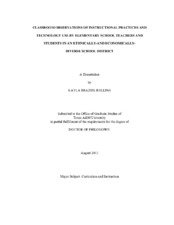| dc.description.abstract | The purpose of this study was to observe pre-kindergarten through fifth-grade public school classrooms to examine differences among instructional practices and technology use by teachers, students and the overall classroom. The current study differed from and built upon previous classroom observational research in a number of major ways. First, the observational data examined both student and teacher technology use and the availability of technology in the classroom. Second, authentic classroom behaviors were examined in relation to technology use; specifically, behaviors related to the impact of technology use on student engagement as well as differences among technology use in classrooms and differences by student socio-economic status. Finally, unlike previous studies, this study focused specifically on pre-kindergarten through fifth-grade classrooms from the same large public school district that was diverse by both socio-economic status (SES) and by student ethnicity.
Overall, the results of this study suggest that technology has not been adequately implemented into the observed classrooms. Technology was available but was not used to a great extent. When technology was implemented, teachers were primarily observed using it to present material and students were observed using it almost exclusively for basic skills activities. This low-level of technology integration occurred in elementary schools of a high performing school district which had a technology plan in place, a low student to computer ratio, and 100 percent of the classrooms had Internet access.
Furthermore, only 15 percent of teachers were observed integrating technology to a great extent; however, students in these classrooms were observed on task significantly more frequently than students in classrooms where technology was observed less or not at all. On the other hand, students were observed off task significantly more in classrooms where either no technology integration was observed or where it was only observed a moderate amount. These findings support and build upon previous observational studies. There is still a need, however, for strong, empirical research to be conducted to further examine the use of technology in elementary classrooms. | en |


